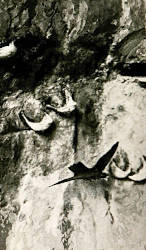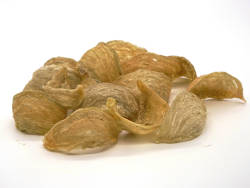Swiftlet


Swiftlets (Collocaliini) are birds belonging to the swift (Apodidae) family. There are around thirty species contained within the four genera Aerodramus, Hydrochous, Schoutedenapus and Collocalia. Many, but not all, species use a simple but effective form of echolocation to navigate in total darkness. They use caves to roost at night and breed. For breeding they build nests on the cave walls.
The nests of some species of swiftlets are edible and used to cook Chinese Birds Nest Soup. The nests of the edible-nest swiftlet (Aerodramus fuciphagus) are called white nests as they are composed almost entirely of the birds saliva and their colour is rather white. The nests of the black-nest swiftlet (Aerodramus maximus) are called black nests, as they contain feathers and twigs and thus have a darker colour. Both are edible, but white nests are easy to prepare for the dish while black nests must be cleaned before human consumption, which is very labour-intensive.
The nests are rare, small, and due to nature protection laws becomes rarer and more expensive every year. White nests are worth between USD 1,000 and 2,000 per kg on the free market. But the highest prized ones are reddish brown nests also called "red blood" nests, which can cost up to USD 10,000 USD for a kilogram. They are believed to be saliva mixed with blood, which the bird expels during nest building. Actually, they are white nests coloured by iron oxide, the rust which also gives the dripstones their red colour and is brought by the dripping water. A bowl of bird’s nest soup costs typically between USD 30 and USD 100. Die essbaren Vogelnester gehören zu den teuersten tierischen Produkten.
The Chinese eat birds nest soup for at least 400 years, which is documented. However, it is guessed they use the birds’ nests for 1,000 years or even 1,500 years for eating and medical purposes. They buy the nests from all countries where swiftlets live, which is South East Asia, including Malaysia and Thailand. The huge karst caves in Gomantong and Niah in Bornea were originally the largest producers of nests. They are still important producers, the nests are collected from the cave walls using bamboo laddders and ropes. But to accommodate the enormous demand, purpose-built nesting houses were erected since the late 1990s. These are usually reinforced concrete structures in urban areas close to the sea, where the birds have the propensity to flock. Center of the trade is Hongkong, most customers sit in Hongkong, mainland China and in the chinatowns of the U.S.A.
As with many Chinese food and medicine recipes, there are a lot of mysteries and mysticism around the birds’ nest soup. They are attributed with remarkable nutritional ingredients, so they are said to be very healthy, even an aphrodisiac. On the other hand, chemical analysis revealed almost no nutritional value at all. So the soup is still one of the most expensive food items in the world, which is probably a result of its extremely restricted availability, not its actual value. And who but the Chinese actually wants to eat soup made of the saliva of birds?
 Swiftlet Cave Munnar, India
Swiftlet Cave Munnar, India Gua Niah, Maylaysia
Gua Niah, Maylaysia Search DuckDuckGo for "Swiftlet"
Search DuckDuckGo for "Swiftlet" Swiftlet - Wikipedia (visited: 17-MAY-2011)
Swiftlet - Wikipedia (visited: 17-MAY-2011) Koreabridge Writings - All is Forgiven by Thor May (visited: 21-MAY-2011)
Koreabridge Writings - All is Forgiven by Thor May (visited: 21-MAY-2011)
 Index
Index Topics
Topics Hierarchical
Hierarchical Countries
Countries Maps
Maps